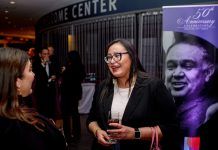No doubt about it, nearly every major technological advance promises a companion leap forward in education. From time saving to expanded future work roles to more accessible delivery of learning materials, improved technologies may assist in better realizing the much-sought goal of all students having equal opportunity for success in reaching their potential for achievement.
No doubt about it, nearly every major technological advance promises a companion leap forward in education. From time saving to expanded future work roles to more accessible delivery of learning materials, improved technologies may assist in better realizing the much-sought goal of all students having equal opportunity for success in reaching their potential for achievement.
The interpersonal connections of students to their teachers are still vital in this endeavor, though. And the Classroom of the Future Foundation seeks out for recognition those educational leaders who teach the teachers how to enlist technologies on behalf of those learners they, in turn, teach. Two East County school principals were honored for their inspirational leadership in incorporating technology into instruction on May 20, as they received the Innovative Principal Award at the 12th Anniversary Innovation in Education Awards event held at the University of San Diego.
Steve Bailey is principal at El Cajon’s Emerald STEAM Magnet Middle School in the Cajon Valley Union School District. (The acronym “STEAM” refers to science, technology, engineering, arts and mathematics.) Bailey was born and raised in East County and for the past year has been principal at the school where he attended junior high classes. His daughters, now five and seven, will go to this school too, for their sixth through eighth grade classes.
This is Bailey’s 15th year in education. “That is part of my philosophy of education,” he said in an interview before receiving his award, “to treat every child like my own child. I take my role very seriously.”
Bailey described the two major reasons he was recognized as an especially innovative principal. “At the beginning of this year we worked on integrating STEAM in all curriculum areas. We asked ourselves, how are we going to do it? My staff and I were intent on cracking the code. We implemented design thinking, which puts students in charge of asking questions and selecting the process they will use in assigned projects.”
Bailey cited the example of this year’s sixth grade students working on a history project analyzing and comparing road maintenance in ancient Rome and in current-day San Diego, for dealing with potholes. The assigned task was for students to test multiple prototypes and discover the best solution in each setting. Students were thus exposed to engineering principles and practices, weather studies and geography. “This was core curriculum disguised as a project,” Bailey said.
That particular project assignment exceeded expectations. More than 550 kids participated, and over 1,000 visitors toured displays showing the students’ work.
“We need to get out of the teachers’ way and get out of the students’ way,” Bailey summed up. “We should take risks and get rid of the fear of failure paralyzing action. The way to succeed is through making mistakes and learning from them how to do better next time.”
And the second main reason Bailey was honored? “We made a very big, pointed decision to make a priority of access to computer science for the kids. We now host coding sessions six times a month, for four hours each session, including Saturday sessions.” Bailey smiled over schoolchildren voluntarily attending the Saturday classes. He said the goal is “to give kids back how to learn through play.”
And Bailey further noted a troubling jobs gap, in which technology firms outsource employment because too few Americans have the work skills required for the positions to be filled. He discussed nearby East County technology enterprises and his intention to involve these businesses in collaboration to excite the children about possible future work roles.
“This is a way to disrupt the system a bit and give East County kids a leg up,” he said.
He expects to expand access to the computer science sessions to more East County students, to add coding labs, and within five to seven years to have built out a computer science department at his middle school.
“There is a constant buzz over fostering creative liberty with learning technology, and enthusiasm and energy when the kids are engaged,” he said. “We all see tangible outcomes from this approach. We are overcoming barriers and helping students from all over the district.”
Rick Oser leads the Lemon Grove Academy for the Sciences and Humanities as principal for students ranging from preschool through eighth grade. He has worked in the Lemon Grove School District for 18 years, and for 10 years as a principal. This is the first year he has received an education innovation award.
The Lemon Grove Academy opened the middle school grades three years ago and from the outset has been a leader in introduction of technology into the curriculum. Oser is principal for both of his own children, a 13-year-old daughter and a son, 11, who attend the academy.
“Lemon Grove really has a small town feel,” Oser observed. And he noted that he enlists community engagement in his school’s endeavors whenever and however possible.
Oser explained his views on education, saying, “We see our mission as helping students explore the questions, who am I, what do I aspire to and what path will take me there?” He noted that early adolescence is the time of life when youth form their sense of identity and that teachers have significant influence in shaping their students’ lives at this age. He further discussed how technology and innovative methods could help in “breaking down barriers.”
“We want to plant some seeds, so that students can figure out what they want to do,” Oser said. A particular focus at the Lemon Grove Academy is partnering with UCSD Medical School. “We give the children access to role models this way,” Oser continued. “And we encourage our students to develop an interest in professions in the health field.” A clinic and dental clinic at the school offer both on-site medical care and learning experiences for those considering a job in medicine. Oser cited a mid-May week when students taught classes to other students on their training in the clinics.
“We made a conscious decision to leverage technology” for students, Oser said. He said how the selection of proper devices and strategies “to support them made the kids more active in the classroom. The kids are showing us new processes in teaching. We set a ceiling, and they push the ceiling higher. We are training citizens for the future.”














